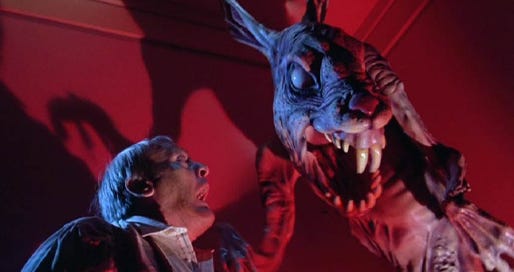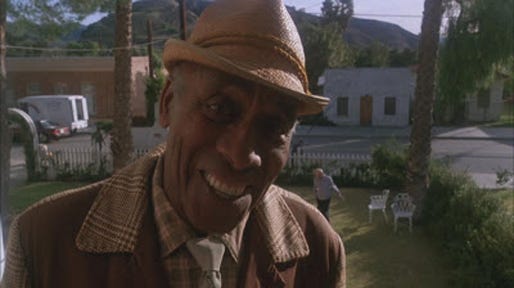Class of 1983: "Twilight Zone: The Movie"
In the “Class of …” series, we take a monthly look back at films celebrating either their 20th or 30th anniversary of initial release this year — six from 1993 and six from 1983. The rules: No Oscar nominees and no films among either year’s top-10 grossers.
The legacy of Rod Serling’s “The Twilight Zone” has far outpaced the five years during which this avant-garde assemblage of short-form sci-fi, suspense, fantasy and horror originally aired on CBS. Since its original incarnation, there have been two TV revivals and, more recently announced, a movie version to be directed by Joseph Kosinski (“TRON: Legacy” and “Oblivion”).
For anyone who’s spent any significant amount of time with the original episodes, it’s easy to see why it's endured. Serling and his writers deftly tempered otherworldly narratives with macabre, metaphysical meditations that were oftentimes disturbingly and discomfortingly familiar. The best episodes are moral Rorschach tests thrust into your face — coldly observational mental probes that remain as unnerving now as they must have felt during their premiere in the tumultuous first half of the 1960s.
“Twilight Zone: The Movie’s” attempt to anthologize these sensations on a much larger canvas must have seemed like a no-brainer — bringing together A-list directors John Landis (“The Blues Brothers”) and Steven Spielberg (“E.T.”) and up-and-comers Joe Dante (“The Howling”) and George Miller (“The Road Warrior”) for a quartet of stories either updated from the series or written for the screen. (There’s also a flimsy new prologue with Dan Aykroyd and Albert Brooks, which gets dark, desolate highway imagery right but drifts into banality long before its boo scare.)
Unfortunately, “Twilight Zone: The Movie’s” legacy endures for a far more regrettable reason, as a low point in Hollywood’s history of stunts gone wrong.
The accident occurred on a studio stage in summer 1982, as director John Landis was filming the centerpiece of “Time Out” (the film’s sole original segment, which he also wrote). In it, Vic Morrow — best known as the star of TV’s “Combat!” — is Bill Connor, a modern-day bigot who enters a time loop where he’s subjected to race-based atrocities of history, such as Nazi occupation and KKK lynchings.
As written, Connor was to have been redeemed after carrying two Vietnamese girls to safety — while U.S. Army helicopters destroyed the village behind them.
There was already a tenuous grasp on safety — helicopter pilots flying low in an enclosed area, explosive charges ladled around them. But after a technician unknowingly detonated two charges too close together, debris caused a helicopter to spin out. It crashed atop Morrow and child actors Myca Dinh Le and Renee Shin-Yi Chen — decapitating Morrow and Le, and crushing Chen under the skids.
Without waivers, California law then prohibited the use of child actors in proximity to explosions, late at night, and without the presence of a teacher or social worker. Perhaps certain they wouldn’t receive a waiver because of their intentions, Landis and company never sought one — illegally hiring the kids and paying them in cash.
During criminal and civil litigation that spanned a decade and ended in out-of-court settlements, Landis admitted culpability only to circumventing these rules to hire the child actors. Along with associate producer George Folsey Jr., production manager Dan Allingham, pilot Dorcey Wingo and explosives specialist Paul Stewart, Landis was eventually acquitted of manslaughter charges after a lengthy trial.
“Time Out” was the first segment filmed for “Twilight Zone: The Movie,” and after the tragedy, Spielberg (undoubtedly the movie’s unifying creative glue) considered abandoning the project then and there.
Still, production pressed on, and while omitting “Time Out” altogether would seem to be the only tactful course of action, there it dangles as a full section of the movie — an albatross around the neck of the entire endeavor. (Its eventual use was enough for a second assistant director to claim an Alan Smithee credit and may have inspired Oscar-nominated “E.T.” screenwriter Melissa Mathison to assume the pseudonym Josh Rogan as co-writer of Spielberg’s segment.)
Without question, the film would have been better off junking “Time Out.” Never does it create a feeling of authentic dread, just the lingering ghoulishness of a real-life tragedy. And as if featuring an actor whom audiences knew died because of this film didn’t ooze enough slime, “Time Out’s” nihilistic new ending makes it feel even more unsavory.
Connor still emerges in the swampy paddies of Vietnam — perhaps just steps from the spot where Morrow would eventually die. There, he’s fired upon by American soldiers, who stop after a wisecrack about Niedermeyer getting fragged by his own troops — a callously clueless callback to a joke from Landis’s 1978 breakthrough hit, “National Lampoon’s Animal House.”
Connor then returns to Nazi-occupied France, where he’s loaded on a train bound for a concentration camp — pointlessly calling out to his buddies in the present day that can neither see nor hear his plaintive cries as he’s carted off to certain death. It hardly seems an understatement to suppose this may be how Morrow’s own family and friends must have felt watching “Time Out” — stuck in a similarly futile position, powerless to help. Hard to swallow or shake, the inclusion of “Time Out” is a nadir of poor-taste filmmaking all around.
Hardly a shock, then, that Spielberg shifted his focus from adapting “The Monsters Are Due on Maple Street” — about a neighborhood violently invaded by aliens — to the unabashed sweetness of “Kick the Can.” It’s an abnormal take on the Americana of Norman Rockwell that spins the movie from menacing to mawkish. Scatman Crothers (“The Shining”) plays an optimistic old man at a rest home, who entices his fellow residents with the prospect of literally regaining their childhood.
There’s tough, if tertiary, talk about how society shuns even our most beloved family members aside once they hit decades that start with “s.” Composer Jerry Goldsmith musically uncovers the story’s somber and hopeful connotations. And you can see in it a sort of preface to ideas that intrigued Spielberg about a long-form re-envisioning of Peter Pan in “Hook” eight years later.
But this moon-eyed meditation on the memories of yesteryear is a good 12-minute idea stretched out to 24. At least it ends on a nice bit of poetry as the octogenarians ponder the peril of going through life alone, without the loved ones they once knew. If nothing else, this modest marriage of melancholia and magic leaves you upbeat about what’s left of the movie after the metallic, bitter aftertaste of “Time Out.”
All told, you’re best to simply skip to “It’s a Good Life” and “Nightmare at 20,000 Feet” — vignettes overseen by then-upstarts Joe Dante and George Miller. In the ensuing two years, they got their unforgettably great big-budget showcases (“Gremlins” and “Mad Max: Beyond Thunderdome,” respectively). But here, they were content to outshine A-list collaborators with short films that still stack up.
It’s hardly a coincidence, either, that the scripts for both are solely credited to the late, great Richard Matheson — a writer for 16 episodes of the original series, as well as the author of “I Am Legend,” “What Dreams May Come,” “Hell House,” “A Stir of Echoes” and many, many more literary classics.
Dante’s “Life” concerns Helen (Kathleen Quinlan), a teacher en route to a new job and a new life whose altruistic defense of Anthony, a bullied young boy (Jeremy Licht), leads to a bizarre discovery.
As Helen learns when Anthony invites her for dinner, the boy’s family is actually a random collection of strangers — trapped in his home by his impulsive imagination, which violently manifests itself on a whim.
“Life” effortlessly lures us into its uneasy, unpredictable headspace for a couple of reasons. The first is triumphant production design and cinematography within Anthony’s house, where the hallways seem to elongate and the shadows wreak havoc on angular corners. It’s a mesmerizing marriage of Escher drawings, German Expressionism and Tex Avery cartoons.
The other is Matheson and Dante’s unassailable command over the story’s themes of power and control. Beaten down by the outside world, Anthony knows he holds court here, and he barely corrals a despotic smile as he lets his “family” know he’ll be down for dinner. (“I always like to let them know when I’m coming,” he says.) That the actors — among them craggy-faced luminary Kevin McCarthy — seem so easily posed mentally and physically makes it feel even more like a demented dollhouse in which they’re trapped.
Dante’s macabre visuals have always straddled a line between childlike wonderment and full-fledged freak-outs. (See almost every moment in “Gremlins.”) The same holds true here, with demonic animatronics that materialize from the darkest depths of Anthony’s mind and feel dangerous but a bit daffy as well. However, the resolution of “Life” is unexpectedly, interestingly dark — a peace with Danny that Helen strategically brokers in a way which feels more exploitative than maternal.
Finally, there’s “Nightmare,” which starts at an intensity level of 9 and keeps cranking long after the knob has broken off in its hand. Thanks to Allen Daviau’s relentlessly claustrophobic camerawork and a virtuoso performance from John Lithgow, it plummets the audience into clammy-palmed panic of supernatural suspense and psychological terror.
“Nightmare” terrifically toys with its protagonist’s skewed mental perception from the get-go. We meet John Valentine (Lithgow) when he’s locked himself in an airplane bathroom — crammed into the corner, sweat-soaked with anxiety and popping pills to quell his fear that the plane’s destination is the cold, hard ground.
What he hears is the menace of a loud, impatient pound on the bathroom door. In actuality, it’s the light rapping of a concerned flight attendant. (It’s refreshing that the flight crew plays so earnest and genuine about coaxing Valentine out of there. Clearly, they want to engage him without being condescending, but they’re also fully aware of how nervous he’s making his fellow travelers.)
Once he’s in his seat, Valentine seems settled. But then, he glances out his window and sees something skittering out on the wing, maniacally yanking wires to and fro until an engine gives out. Is it Valentine’s racing imagination? A hallucination brought on by his medication? Or is it really a goblin hell-bent on dooming them all and riding the wreckage all the way down a la Slim Pickens in “Dr. Strangelove”?
With hair as wild as his eyes, the pale, howling Lithgow makes every furtive movement feel like a yank at the frayed ends of Valentine’s sanity. Here’s a man who makes a living writing textbooks about logic who finds his very faculties abandoning him in front of a large, unforgiving audience. His glances to see whether the creature is out there exist not as a cheap device to push the story forward but as Valentine’s hope that he can hold onto a last shred of reason.
“Nightmare” takes on the tone of a cacophonous campfire tale, enlivened by the devil’s-dance violins of Goldsmith’s score (a tonal opposite of his work in Spielberg’s segment) and expertly ratcheted tension. Plus, even if you know how it ends, the payoff still raises plenty of hell and hair on the back of your neck.
So, where does the movie ultimately wind up? Perhaps it’s best to say somewhere in a fifth dimension beyond that which is known to most films.
It is the middle ground between wowing and worthless, between so great and so what, and it lies between the pits of recklessly fatal hubris and the very summit of spirited genre filmmaking.
This is the dimension of an anthology film released in 1983. It is an area which we call “Twilight Zone: The Movie.”




